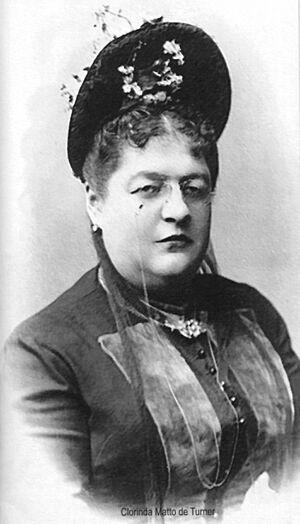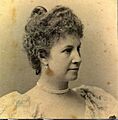Clorinda Matto de Turner facts for kids
Clorinda Matto de Turner (born September 11, 1852, died October 25, 1909) was an important Peruvian writer. She lived when many countries in Latin America were becoming independent. Clorinda was a very independent woman herself. Her writings often caused discussions and made people think. She inspired many women in her region.
Contents
About Clorinda Matto de Turner
Clorinda Matto de Turner was born and grew up in Cusco, Peru. Her parents were Ramón Mato Torres and Grimanesa Concepción Usandivares. After her mother died, people called her Azucena de los Andes, which means "Lily of the Andes." Her birth name was Grimanesa Martina Mato, but her friends and family called her Clorinda. She originally had one "T" in her last name. Later, she added an extra "T" to "Matto" because she loved the Inca culture.
Clorinda spent most of her childhood on her family's farm, Paullo Chico, near the village of Coya. As a teenager, she went to a school now known as the Escuela Nacional de Educandas. There, she took some unusual classes for girls at that time. She studied subjects like Philosophy, Natural History, and Physics. Clorinda left school at age sixteen to help take care of her brother and father.
In 1871, when she was 19, Clorinda married Dr. Turner, a rich Englishman. They moved to Tinta and lived there for 10 years. In Tinta, Clorinda learned a lot about Peru's past. She studied both the colonial history and the history of the Inca people. She became very familiar with the culture of the native people. The more she learned, the more she respected it. Much of her writing was inspired by what she learned from them.
Clorinda also worked as a journalist for local and international newspapers. In 1878, she started her own magazine called El Recreo de Casco. It featured articles on literature, science, art, and education. She became known for her writings that showed native people in a good way. This was different from how many people in her society viewed them. Even though she was of white background, she disagreed with how Peru's native people were treated. She used her writing to speak up for them. Clorinda Matto de Turner also wrote to support better education for women.
Challenges and New Beginnings
In 1881, Clorinda's husband died. He left their estate bankrupt, meaning they had no money. She could not improve her financial situation in Tinta. So, Clorinda moved to Arequipa. There, she became the editor-in-chief at a newspaper called La Bolsa Americana. While in Arequipa, she published two books of "tradiciones cuzqueñas" (Cusco traditions). She also wrote a play called Himacc-Suacc in 1884. She even translated the four Gospels into Quechua. Quechua is a language spoken by the native people in Peru. Besides her writing, she also got involved in politics. She helped raise money to build a battleship called Almirante Grau.
Clorinda Matto de Turner later moved from Tinta to live in Lima. However, because of her political and sometimes controversial writings, she often thought it would be safer to live outside of Peru. In Lima, she joined many different literary groups and publications. In 1887, Clorinda became the director of El Peru Ilustrado. She published many of her novels in this newspaper. Between 1889 and 1895, she published three novels: Aves Sin Nido (Birds Without a Nest), Indole (Character), and Herencia (Heredity). These novels talked about how native people were losing their rights. They also spoke about how they were treated badly by some in the community and by selfish priests.
Clorinda Matto de Turner's most famous novel was Aves Sin Nido (1889). This book was controversial. It showed a love story between a white man and a native woman. This was not accepted in Latin American society at that time. The book also spoke about the bad behavior of some priests. The characters in the novel could not marry because they found out they had the same father, who was a priest. Aves Sin Nido was not her only controversial work. She also published a controversial story by a Brazilian writer named Henrique Coelho Neto in her newspaper. Her controversial writings led to her excommunication by the Archbishop. This meant she was no longer allowed to be part of the church.
Life in Exile
In 1895, Clorinda moved to Buenos Aires, Argentina. She continued her writing activities there. In 1900, she wrote Boreales, Miniaturas y Porcelanas. This was a collection of essays. It included "Narraciones históricas," which showed her deep sadness about being forced to leave Peru. It also showed how much she wanted to return. In Buenos Aires, Clorinda Matto de Turner started Búcaro Americano. She also gave many public talks and wrote many articles for newspapers. Clorinda spent most of her time teaching as a Professor at a local university. In 1908, she visited Europe for the first time. She carefully wrote about this trip in her book Viaje de Recreo (Trip of Amusement). The book was published in newspapers after her death in 1909.
Images for kids
See also
 In Spanish: Clorinda Matto de Turner para niños
In Spanish: Clorinda Matto de Turner para niños



